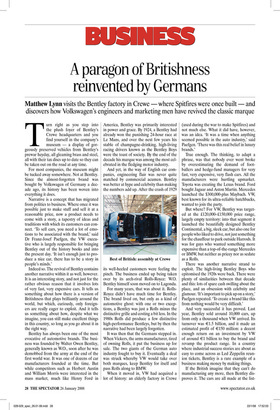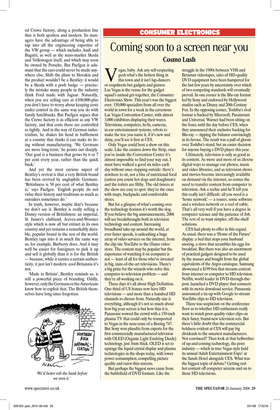A paragon of Britishness reinvented by Germans
Matthew Lynn visits the Bentley factory in Crewe — where Spitfires were once built — and discovers how Volkswagen’s engineers and marketing men have revived the classic marque Turn right as you step into the plush foyer of Bentley’s Crewe headquarters and you find yourself in the company’s museum — a display of gorgeously preserved vehicles from Bentley’s prewar heyday, all gleaming brass and steel, all with their tax discs up to date so they can be taken out on the road at any time.
For most companies, the museum might be tucked away somewhere. Not at Bentley. Since the almost-forgotten brand was bought by Volkswagen of Germany a decade ago, its history has been woven into everything it does.
Narrative is a concept that has migrated from politics to business. Where once it was possible just to make stuff and sell it at a reasonable price, now a product needs to come with a story, a tapestry of ideas and traditions with which its customers can connect. ‘To sell cars, you need a lot of emotions to be associated with the brand,’ said Dr Franz-Josef Paefgen, the VW executive who is largely responsible for bringing Bentley out of the history books and into the present day. ‘It isn’t enough just to produce a nice car, there has to be a story in people’s minds.’ Indeed so. The revival of Bentley contains another narrative within it as well, however. It is an interesting story, and not just for the rather obvious reason that it involves lots of very fast, very expensive cars. It tells us something about how there is a version of Britishness that plays brilliantly around the world, but which, curiously, only foreigners are really eager to exploit. And it tells us something about how, despite what we imagine, you can still make excellent things in this country, so long as you go about it in the right way.
Bentley has always been one of the most evocative of automotive brands. The business was founded by Walter Owen Bentley, generally known as W.O., soon after he was demobbed from the army at the end of the first world war. It was one of dozens of car manufacturers founded at the time. But while competitors such as Herbert Austin and William Morris were interested in the mass market, much like Henry Ford in America, Bentley was primarily interested in power and grace. By 1924, a Bentley had already won the punishing 24-hour race at Le Mans, and over the next few years his stable of champagne-drinking, high-living racing drivers known as the Bentley Boys were the toast of society. By the end of the decade his marque was among the most celebrated in the fledging motor industry.
And yet, in the way of English car companies, engineering flair was never quite matched by commercial acumen. Bentley was better at hype and celebrity than making the numbers add up. After the crash of 1929 its well-heeled customers were feeling the pinch. The business ended up being taken over by its arch-rival Rolls-Royce: W.O. Bentley himself soon moved on to Lagonda.
For many years, that was about it. RollsRoyce didn’t have much time for Bentley. The brand lived on, but only as a kind of automotive ghost: with one or two exceptions, a Bentley was just a Rolls minus the distinctive grille and costing a bit less. In the 1980s Rolls did produce a few distinctive high-performance Bentleys, but by then the narrative had been largely forgotten.
It was then that the Germans stepped in. When Vickers, the arms manufacturer, tired of owning Rolls, it put the business up for sale. The two giants of the German auto industry fought to buy it. Eventually a deal was struck whereby VW would take over both marques, keep Bentley for itself and pass Rolls along to BMW.
When it moved in, VW had acquired a lot of history: an elderly factory in Crewe (used during the war to make Spitfires) and not much else. What it did have, however, was an idea. ‘It was a time when anything seemed possible in the auto industry,’ said Paefgen. ‘There was this real belief in luxury brands.’ True enough. The thinking, to adapt a phrase, was that nobody ever went broke by overestimating the demand of footballers and hedge-fund managers for very fast, very expensive, very flash cars. All the manufacturers were hurtling upmarket. Toyota was creating the Lexus brand. Ford bought Jaguar and Aston Martin. Mercedes launched the $300,000-plus Maybach. VW, best known for its ultra-reliable hatchbacks, wanted to join the party.
But where? For VW, Bentley was targeted at the £120,000–£150,000 price range, largely empty territory: into that segment it launched the beautifully designed Bentley Continental, a big, sleek car, but also one for people who liked to drive, not just something for the chauffeur to park outside Harrods. It was for guys who wanted something more expensive than a top-of-the-range Mercedes or BMW, but neither as pricey nor as sedate as a Rolls.
There was another narrative strand to exploit. The high-living Bentley Boys who epitomised the 1920s were back. There were plenty of similarities between that decade and this: lots of spare cash swilling about the place, and an obsession with celebrity and glamour. ‘It’s important to pick up on a story,’ Paefgen repeated. ‘To create a brand like this from nothing would be very difficult.’ And very successful it has proved. Last year, Bentley sold around 10,000 cars, up from only a thousand when VW arrived. Its turnover was €1.5 billion, and it made an estimated profit of €150 million: a decent enough return on an investment by VW of around €1 billion to buy the brand and revamp the product range. In a country where industrial success stories are about as easy to come across as Led Zeppelin reunion tickets, Bentley is a rare example of a business making money by making things.
If the British imagine that they can’t do manufacturing any more, then Bentley disproves it. The cars are all made at the list ed Crewe factory, along a production line that is both spotless and modern. Its managers have the advantage of being able to tap into all the engineering expertise of the VW group — which includes Audi and Bugatti, as well as the mass-market Skoda and Volkswagen itself, and which may soon be owned by Porsche. But Paefgen is adamant that the cars could never be made anywhere else. Shift the plant to Slovakia and the product wouldn’t be a Bentley: it would be a Skoda with a posh badge — precisely the mistake many people in the industry think Ford made with Jaguar. Naturally, when you are selling cars at £100,000-plus you don’t have to worry about keeping costs under control in the same way you do with family hatchbacks. But Paefgen argues that the Crewe factory is as efficient as any VW factory, and that costs there are controlled as tightly. And in the way of German industrialists, he shakes his head in bafflement at a country that thinks it can make its living without manufacturing. ‘We Germans are more long-term,’ he points out sharply. ‘Our goal is a business that grows by 6 or 7 per cent every year, rather than the quick buck.’ And yet the most curious aspect of Bentley’s revival is that a very British brand has been revived by anglophile Germans. ‘Britishness is 50 per cent of what Bentley is,’ says Paefgen. ‘English people do not value their history and traditions as much as outsiders sometimes do.’ In truth, however, maybe that’s because we don’t see it. Bentley is really selling a Disney version of Britishness: an imperial, St James’s clubland, Jeeves-and-Wooster style which is now all but extinct in its own country and yet remains a remarkably durable, popular brand in the rest of the world. Bentley taps into it in much the same way as, for example, Burberry does. And it may well be easier for foreigners to pick it up and sell it globally than it is for the British — because, while it carries a certain authenticity, it just isn’t modern: cool Britannia it’s not.
‘Made in Britain’, Bentley reminds us, is still a powerful piece of branding. Oddly, however, only the Germans or the Americans know how to exploit that. The British themselves have long since forgotten.











































































 Previous page
Previous page